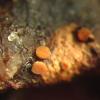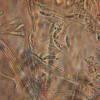
02-01-2026 17:43
MARICEL PATINOHi there, although I couldn't see the fruitbody, I

04-01-2026 17:45
 Stephen Martin Mifsud
Stephen Martin Mifsud
I was happy to find these orange asmocyetes which

03-01-2026 13:08
Niek SchrierHi all,We found groups of perithecia on a Lecanora

29-12-2025 17:44
Isabelle CharissouBonjour,J'aimerais savoir si d'autres personnes au

01-01-2026 18:35
Original loamy soil aside a artificial lake.The co

31-12-2025 19:27
Collected from loamy soil, at waterside (completel

Dear friends!
Do you have some idea about the genus of this tiny disco?
I have found it on dead leaves of Quercus robur. Fruitbodies are single, small, orange-beige, 0,2-0,5 mm in diam.
I thought about Pezicula, but apical rings are blued in IKI (colourless in MLZ)
Spores are ellipsoid, 10,9-11,4*2,4-3,6 um, hyaline, with 2-3 guttules (in water, KOH).
Thank you before,
Irina

Raúl

Yes, that might be right guess....it seems to me that asci are of Calycina type reaction (although there are number of genera apart from Calycina with that type of euamyloid reaction). Perhaps a drawing of some cell types, most preferably in statu vivo (see Baral 1992 publ. in Mycotaxon, which I can send if still needed) and observation on paraphysal & excipular layer(s) structure & gelification would be sufficiently informative. Also ascogenous system type (croziers vs. simple septate) is crucial. it is not necessary to draw whole block of texture(s) or hymenia - only group of cells.
Cordially,
Neven





